
This page (Page
#2) has creative activities for use in the classroom. Kids love
to learn more about the play’s origin and subject. Check
out these articles and activities related to ArtReach’s popular
titles: Amelia Earhart, Pinocchio,
Reluctant
Dragon, Sword in the Stone, Peter
Pan, Robin Hood, Poe!
Poe! Poe!, Sleeping
Beauty, Nutcracker Prince, A
Thousand Cranes, Mulan, Jungle Book.
Don’t forget, a Teachers
Guide will come with your School Play Package and contains tons of
creative new ideas for your teaching lessons!

ArtReach's
Amelia
Earhart, Background
Info for Performance
Study
Guide Material from Lexington Children's
Theatre
What
happened to Amelia? The questions surrounding her disappearance, the
theories of conspiracy and romance, the latest discoveries that may
or may not confirm her fate-Amelia Earhart's story has captured
imaginations for generations. Step back in time with the First Lady
of Flight to unravel the mysteries and fly along on her daring
adventures across the world.
"What
happened to Amelia?"
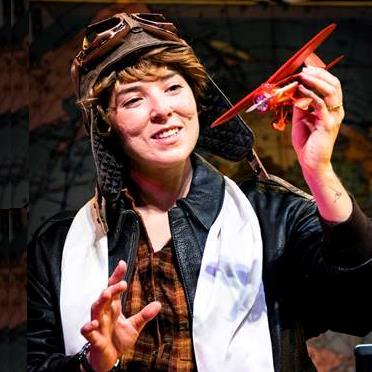
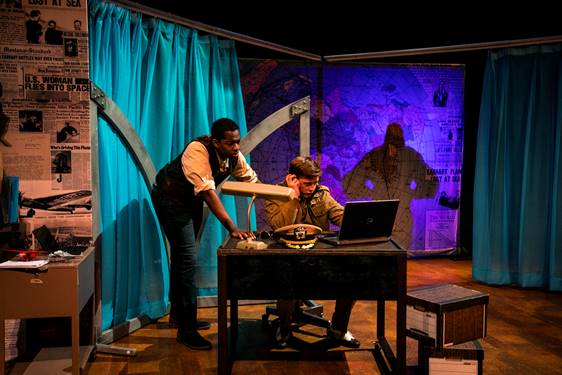
ArtReach's Amelia
Earhart - The Rev (aka Merry-Go-Round Playhouse) Auburn NY
Amelia
Mary Earhart was born July 24, 1897. She grew up in Kansas with her
sister, Grace. Amelia and Grace spent a majority of their childhood
outdoors climbing trees, sledding downhill, and collecting small
creatures like bugs and toads. They were homeschooled in their
grandmother's home by their mother and governess. Amelia had a great
love for reading and used her family's gigantic library to her
advantage. She did not enter public school until she was twelve years
old and beginning the seventh grade. Her adventurous spirit and
critical thinking mind would serve her well in her future career.
During her life, she became a pioneer in American aviation and even
wrote books about her flight adventures. Earhart was the first woman
to fly alone across the Atlantic Ocean. She used her experiences and
her reputation as a pilot to form an organization for other women
pilots called The Ninety Nines and worked at Purdue University as an
aeronautical engineer and career counselor to female students. She
was also a fighter for equality and was an active member of the
National Woman's Party. Unfortunately, Amelia's success and work had
to come to an end when during an attempt to fly around the globe she
disappeared along with her navigator, Fred Noonan, and plane. No
trace of Amelia has since been found and there is still a lot of
mystery surrounding her last flight.
"There
is still a lot of mystery surrounding her last flight."
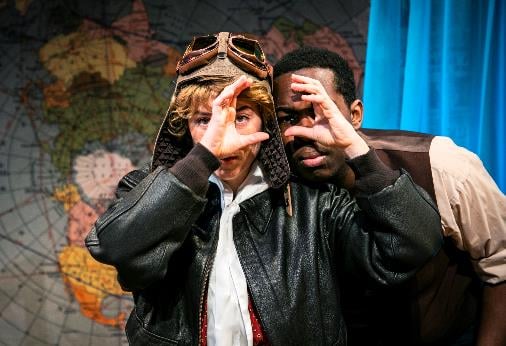
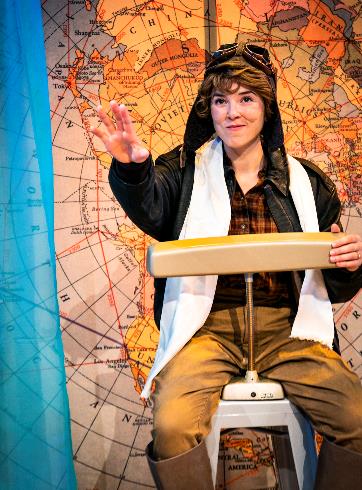
ArtReach's Amelia
Earhart - The Rev (aka Merry-Go-Round Playhouse) Auburn NY
Amelia
Earhart is one of America's most well-known historical figures.
Please familiarize your students with her story before coming to see
AMELIA EARHART. Use these questions to help foster students'
interests with Amelia and her mysterious story.
1.
Amelia planned a trip
where she would travel the circumference of the globe all on her own.
Think about the longest trip you've taken, but imagine you were all
alone. Infer: -How do you feel about your trip? -What are some things
you need to bring with you? -What will you do if you find yourself in
a dangerous situation (i.e. car trouble, lost, etc..) on your trip?
-How will you prepare yourself for your long journey?
"What
do dreams know of boundaries?"



ArtReach's Amelia
Earhart - The Rev (aka Merry-Go-Round Playhouse) Auburn NY
2.
Read the following quotes
from Amelia Earhart and then discuss: "There's more to life than
being a passenger." "Courage is the price that life exacts
for granting peace." "Everyone has oceans to fly, if they
have the heart to do it. Is it reckless? Maybe. But what do dreams
know of boundaries?" "Women, like men, should try to do the
impossible. And when they fail, their failure should be a challenge
to others." o What personality traits can you infer Amelia
Earhart has by reading her quotes? What was important to her? What
did she believe in? o Is Amelia Earhart someone who should be
admired? Why or why not? o Why would courage and bravery be so
important to Amelia Earhart?
3.
Amelia Earhart did not complete
her trip around the world, and was never heard from again. What do
you believe happened to her? What caused her to not make it safely
back home?

Pinocchio:
CLASSROOM EXERCISES & ACTIVITIES
General
Preparation:
Read
the synopsis of the play as it appears in this Teachers Guide. What
do you think is the "main theme" of the story?
Consider other stories that the students are familiar with such as
Cinderella, Snow White and the Wizard of Oz. What aspects of
the these stories are the same? Which are different?
"It
is set in a magical, long ago world."


Siena Heights University
performs ArtReach's Pinocchio.
Theatre Siena's Creative
Stages program is offering the children's production of
"Pinocchio," Saturday and Sunday, on the Haller Stage of
the Spencer Performing Arts Center on the Siena Heights University
campus. The show features young actors from across Lenawee County
involved in the Creative Stages Program. "Pinocchio" is
being directed by Joni Warner, SHU associate professor of theater.
Siena Heights student, J.J. Hoss giving direction to the young
performers Tuesday during dress rehearsal for "Pinocchio"
by Creative Stages at Siena Heights University. Drew Honeywell stars
as Lorenzo in "Pinocchio".
What
mistakes do you think Pinocchio
made in the story? When is he selfish? When is he kind
and brave? What are his consequences and rewards for his actions?
Can
students think of times when they've felt or acted like Pinocchio?
Most
children today are familiar with the Disney film version of the
story. The original story by Collodi is longer and includes
many scenes that are not in the movie. Can the students
identify differences and similarities? Why do you think Disney
made these changes?
In
the original story the cricket is called simply Talking
Cricket. The Disney version gave him a name. Do know this
name? What is the Talking Cricket called in the ArtReach Plays
version? Why do you think he is named that?
"The
story of Pinocchio is loved throughout the world."
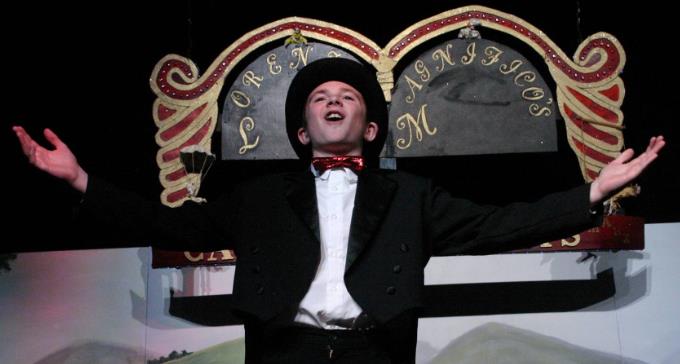
ArtReach's Pinocchio
- The Sauk Theatre, Jonesville MI
Have
the students make a hand puppet from a sock. What kind of
expressions and characters can they portray?
Have
students find or bring objects to class that they wouldn't
ordinarily think of as a puppet - a paper bag, a sock, a scarf,
a mitten. Can the students make their object come to life?
The
story of Pinocchio was first published in Italy. Although it
is read widely there are some aspects of it that remain Italian.
Can you name what those things are? What are the thing Italy
is best known for? Paintings, food, music? Have the
students discuss the distinct nature of these things and explore how
Italian culture has developed them.
Why
do you think the story of Pinocchio is loved throughout the
world? Can you name any other stories that have gained
recognition with children everywhere?
Every
country in the world has fairy tales. The Brothers Grimm
collected these stories in Germany and set them to paper so that all
could read and not forge them. Other fairy tales are stories
that writers have made up. What is the difference between
Grimms' fairy tales and Pinocchio?
Discuss
common elements one might find in a fairy tale and pinpoint these
elements in Pinocchio:
It
is set in a magical, long ago world.
There
is an element of magic or make believe.
Fairies
or talking animals may be present.
There
are good and evil characters.
There
is a problem to be solved.
There
is a happy ending.
"Creative
Play: Painting the Music Game"
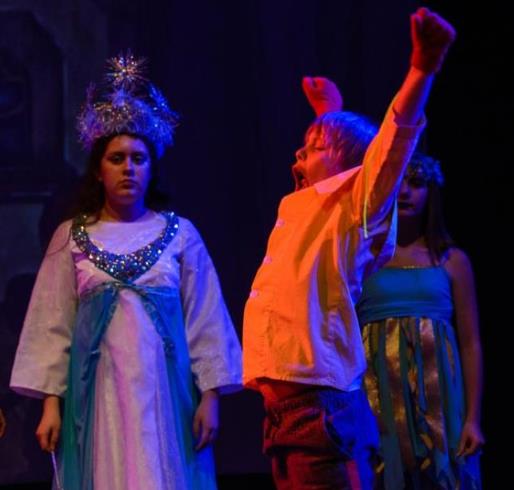
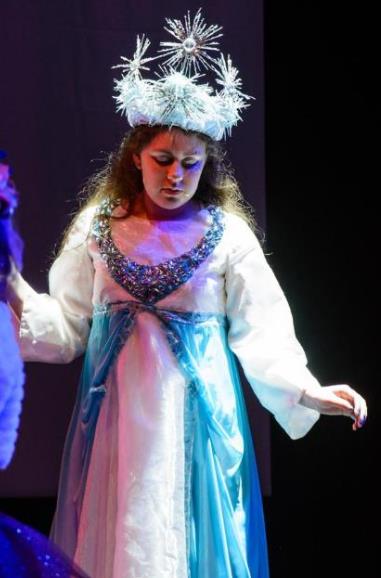
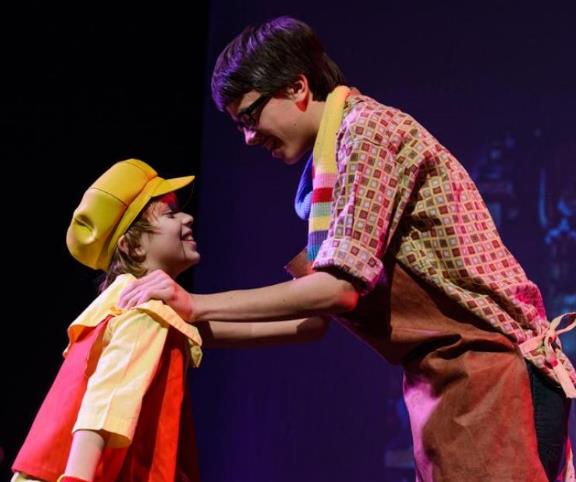
Siena Heights University
performs ArtReach's Pinocchio.
Madisen Mattox as the Lucky
Star is pictured Tuesday during dress rehearsal for
"Pinocchio" by Creative Stages at Siena Heights University.
Pinocchio, Gage Sterling, awakens to find he can move and talk on his
own. Gepetto, played by Seth Bagdon, right, embraces Pinocchio,
played by Gage Sterling, when he wakes up and realizes Pinocchio can
move and talk on his own Tuesday during dress rehearsal for 'Pinocchio'.
Painting
the Music Game: Everyone find a comfortable spot and sit.
Imagine you have a big easel in front of you, with a new blank canvas
on it. In your hand is a palette with every color of paint you
can think of. Select any type of music to play for the exercise
- we suggest using the various selections on the Pinocchio
CD Soundtrack (the pre/post-show music).
(Start
the music.) Listen to the music. Listen especially to the feelings
in the music. How does this music make you feel? What do you think it
is about?
As
you listen to the music, begin to paint what you hear. Some of you
will paint pictures, but some of you will probably just paint colors
and shapes. Whatever you hear is what you should paint.
Really
listen! Listen to the changes in the music. Listen for characters
and listen for events. Whatever you hear, that's what you paint.
These
paintings are really starting to look good!
(When
the music comes to an end--or you make it come to one.) Let's all
finish up our paintings now. They really look fantastic. Everyone
take your painting over to a wall and hang it carefully. Then return
to your seat.
(With
Kindergarten and younger, it only takes about five minutes of music
before the paintings are done. Older or more deliberate children can
take much longer. Use your best judgment.)

The
Reluctant Dragon - Classroom Activities and Discussions
Have fun with Dragons!
OLD
FOLKS: The narrators for this play are called “Old Folks”
because they are the ones who have lived in the village for many
years and therefore know what has happened in the past. Their names
reflect the fact that they are well-respected by the younger members
of the community. Talk about how the older members of your family
affect your life. Can you recount any stories that they have told to
you or your family? Why is it important to take the time to listen to
older people? What kind of older person do you aspire to be? What
stories will you tell your children and grandchildren?
"Let's
Talk
About Local 'Old Folks and Dragons'"

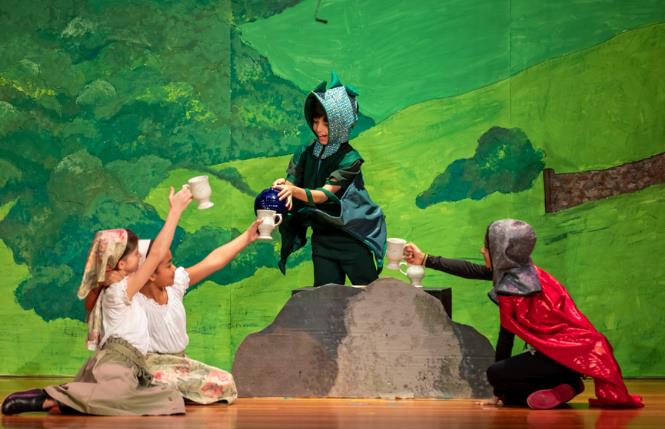
ArtReach's The
Reluctant Dragon Play for Schools - Belmont Day School, Belmont MA
If
you are playing an older person in your play, what things will you
do with your body and voice to indicate age? Why do you think older
people have these mannerisms? Discuss how the characterizations of
age may be conveyed with respect. Consider why many people believe
that an aged face with wrinkles may be very beautiful.
SAINT
GEORGE THE DRAGON SLAYER: This story is very old and has been told
to kids for centuries. There are many versions of the story but most
agree on these plot points: 1. A town was terrorized by a dragon. 2.
A young princess was offered to the dragon. 3. When George heard
about this he rode into the village. 4. George slayed the dragon and
rescued the princess.
After
reading the script summary or seeing the play, name which parts of
the classic story are left out. Read the book and discuss how Kenneth
Grahame changed some of the story. Why do you think he did that? What
is the point of Graham’s story? Does he promote friendship over
fighting? Does he ask us to not judge a book by its cover (i.e.
asking all dragons to be dangerous)? How does he do this?
Write
your own fairy tale story using any kind of dragon and Saint George.
Now add another character. You might add the traditional damsel in
distress. Or consider adding a pirate, a teacher, an insurance
salesman, a super hero. Have them get into an argument together. What
do they argue about? How will they solve the problem?
"Write
your own fairy tale story using any kind of dragon."

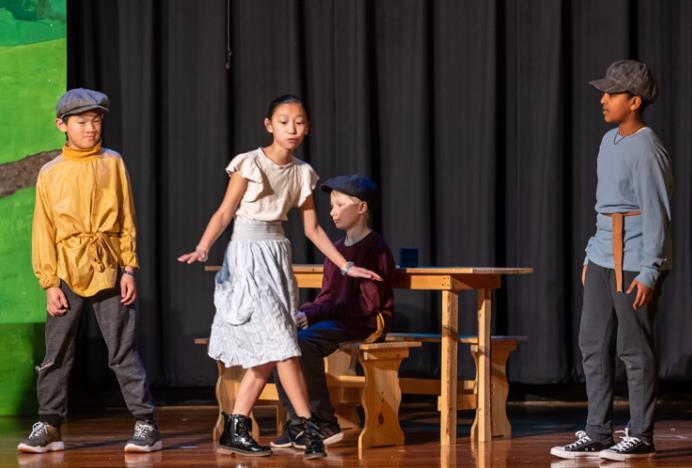
ArtReach's The
Reluctant Dragon - Eisenhower Middle School, Everett WA
SHEPHERDS:
There are many old stories that have shepherds in them. Try to think
of other stories you know that feature shepherds. What are they? Can
you recount the story to theclass? Why do you think the shepherds are
important to the plot? Pretend you are a shepherd on a hill and you
see something happening far away. What is it? Write the story.
SHEEP:
In the play the shepherds indicate that they are being followed by
their sheep by making the braying sound. Pretend to be a farmer or
livestock owner. What animals would you herd and what sound would you
make to indicate your animals are all around you? How do they act
when you talk to them and feed them? Show the class.
PRETEND
LANGUAGES: In the play, Mortimer speaks for a while in Dragonese,
which sounds like gibberish since it is a language the author made
up. Pretend you are having a tea party using a made-up language. What
is your pretend language called? Remember that you must be
consistent. For instance if you use the made up word
“lo-shee-woh” to ask for tea, you must use the same word
each time you ask for tea. Have fun using pretend languages for other
activities: washing the car, watching a football game, training your dog.
"Train
your
dragon in three easy steps!"
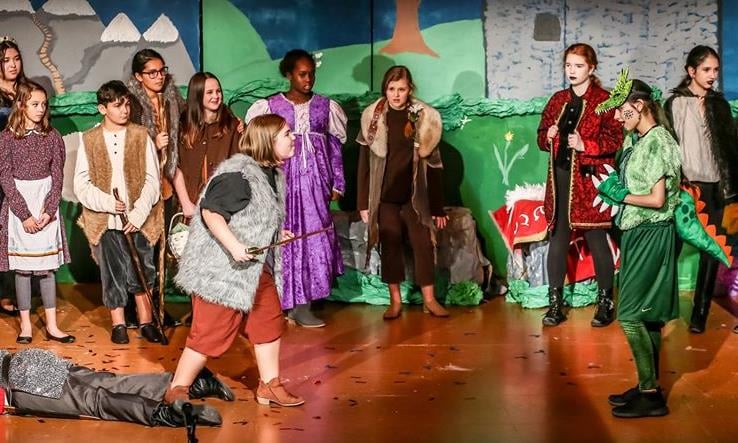
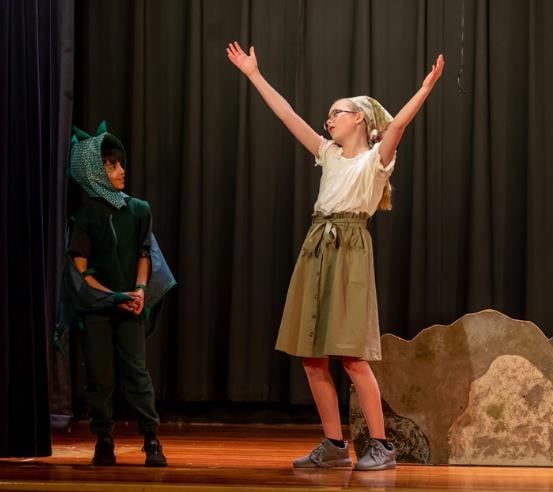
The
Reluctant Dragon - Eisenhower Middle School, Everett WA -
Belmont Day School, Belmont MA
GRODY
GOBSTERS: In the play, Grody Gobsters are bullies who bother Widget
and Hairytoes by making fun of them. Discuss bullies and the kinds of
things they say to you or your friends. Act out a scene of bullying
on your playground. First play the bully and then play the one who is
being bullied. How does it make you feel? What should you do when
someone bullies you or your friends? Now play your scene again acting
with respect and no bullying.
MEDIEVAL
VILLAGE: The Villagers in The
Reluctant Dragon live in a Medieval village that might have
existed 500 years ago. Imagine your own small village and draw a map.
What does the Blacksmith do? Where is his shop in the village? Where
is your house? Where does the King live? The town in the play is
called Pleasant Valley. What if it had been called the Icy Outback,
the Frightful Farm or the Desperate Desert? How would these titles
affect your village? Think of your own name and draw a landscape
picture of it.
"Include
kindness and love."
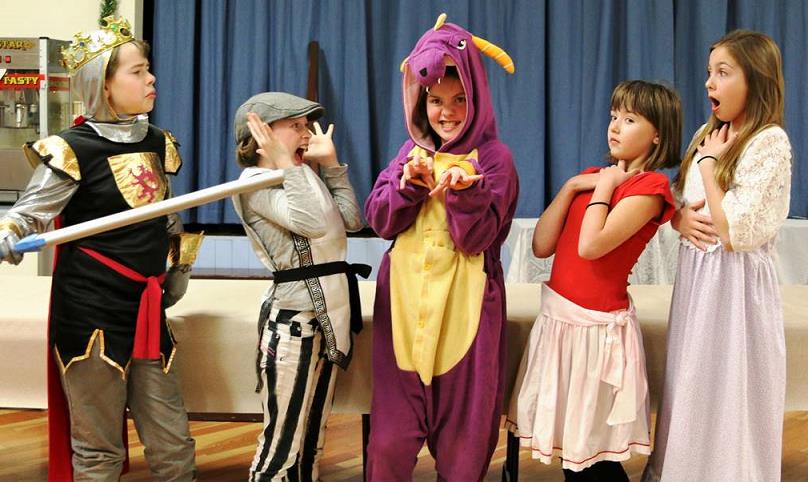
The
Reluctant Dragon - Hemphill Little
Theatre, Hemphill, TX
GURU
GUYS: In this play the Master Guru is a wise man who lives on a hill
and tells people what they should do. Think of other kinds of Gurus
who might be in scene. For instance, what if the Guru was a rock
star, the president or your school principal? What questions would
you ask him or her? Considering their background how would these
individual Gurus respond to your questions? Create a scene and show
the class.
HOW
TO TRAIN YOUR DRAGON: In this play the Guru gives Widget a handbook
on how to train a dragon. Write your own handbook on how to train
your dog, your cloud or your flower. Think of other things you might
train. What is the most important thing the Guru tells Widget to do?
Will your training include punishments? Will it include kindness and
love? Which of these strategies do you think will be the most successful?
See
More in ArtReach Teacher's Guide Available with School Play Package
for The Reluctant Dragon.

The
Show Report: Announcing SRT
in Schools ArtReach's 'Sword
in the Stone'
Arts
& Entertainment Reviewer, Chris Daniels, Orange County CA
Sierra
Repertory Theatre is delighted to announce that a streaming digital
production of "The Sword in the Stone" is now available for
streaming. The magical 45-minute adventure is part of SRT in Schools,
our touring program that brings professional theatre to our county's
schools absolutely free of charge.
SRT
in Schools and "The
Sword in the Stone," are sponsored by Mary Stuart Rogers
Foundation, Sonora Area Foundation and the California Arts Council.
SRT in Schools began in the fall of 2019 with "The Commedia
Cinderella," and continued into 2020 with "Peter
Rabbit," though was forced to close after one performance due to
the state's stay at home order.
"A
lot of people were asking if this would be available to rent,"
says Jerry Lee, Associate Artistic Director for SRT. "After
further negotiations with the author and updating our website to be
able to handle a streaming production, we're so pleased to be able to
offer the show to anyone who wants to see it!" The streaming
digital production is available for $10 per three-week rental.
"We're
able to offer the show to anyone who wants to see it!"

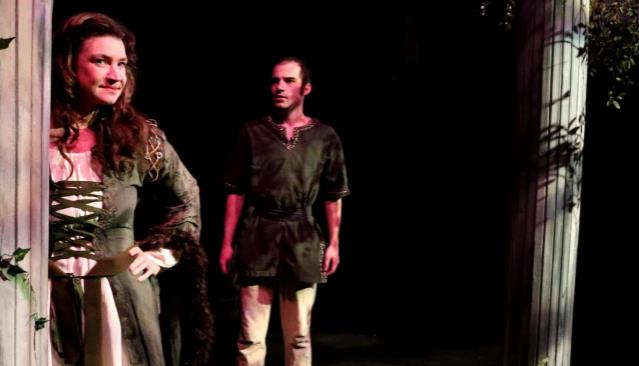
Sierra
Repertory Theatre performs ArtReach's
Sword in the Stone
"We're
proud of what we've been able to accomplish during this unusual
time," says Scott Viets, Producing Artistic Director for SRT.
"Our SRT in Schools program has been put through the wringer
from the outset: Power outages during "Cinderella," the
shelter-in-place mandate during "Peter Rabbit" into
cancelling our entire season in 2020. But we are
committed
to honoring our promise to the community to provide access to
professional theatre for our local youth. We thank our sponsors for
their tremendous support, and we hope that you too will support our
educational programming by purchasing a rental to "The Sword in
the Stone."
"Thanks
to you, your donations have provided us with a lifeline during these
strange and uncertain times," added Viets. "We are
completely blown away by your fierce support, humbled by your
graciousness, and inspired by your dedication."
In
the show, Merlin, the winsome wizard of Camelot, guides Arthur
through life's lessons as the young pupil grapples with sibling
rivalry and his desire to be a knight instead of a measly squire to
his big brother Kai. The 45-minute play is packed with comedy, drama
and excitement as students see Arthur become a fish, a bird, battle a
dragon and reach the sword in the stone. In the course of his studies
Arthur learned the meaning of "real magic" and found
himself worthy of his awesome duty.
The
author of this adaptation, Kathryn Schultz Miller, has penned over
70 plays for young audiences. Her numerous awards include the
prestigious National Endowment for the Arts Playwriting Award. She
served as Artistic Director of the professional ArtReach Touring
Theatre for over 20 years. With plays produced around the world,
Miller is one of the nation's most produced playwrights for young people.
"The
45-minute play is packed with comedy, drama and excitement ."
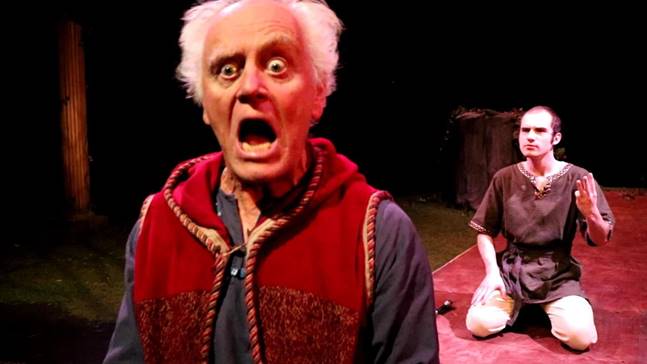

Sierra
Repertory Theatre performs ArtReach's
Sword in the Stone
"The
Sword in the Stone" is a novel by British writer T. H. White.
It was published in 1938 as a stand-alone work, but later became the
first part of a tetralogy, "The Once and Future King."
The
SRT in Schools production stars audience favorite Ty Smith (SRT's
"Guess Who's Coming to Dinner," "Disney's Beauty and
the Beast") as Merlin, the frenzied Wizard who narrates the
journey. Betsy Moore (SRT's "Grease," "Ripcord")
returns in dual roles as the roguish Sir Kai and as the crafty
Princess Guenever. Kyle Moses (SRT's "Grease," "Holiday
Jukebox") takes the stage as the earnest young Arthur. "The
Sword in the Stone" is directed and designed by Jerry Lee, with
combat choreography by Ty Smith, and lighting by Joanna Hobbs.
For
viewing, and more information about Sierra Repertory Theatre's SRT
in Schools, please visit www.SierraRep.org or call the Box Office at
(209) 532-3120. Follow Sierra Repertory Theatre on Instagram at
@SierraRep; and on Facebook at Facebook.com/SierraRep.

ArtReach's
PETER PAN
General
Discussion / Questions
Why
does Peter come to Wendy's house?
Do
you ever feel like Peter did about never growing up?
"Why
does the Crocodile go tick-tock, tick-tock?"


ArtReach's "Peter
Pan" - Ardtornish School, St Agnes, SA Australia
What
did Peter lose that Wendy has to sew back on him?
Why
is Captain Hook called "Hook"?
Why
does the Crocodile go "Tick-tock, tick-tock"?
In
the original story Tiger Lily's tribe are called "Indians".
What's another name for Indians? Are they really from India?
How
do you make a sick Fairy like Tinker Bell get better?
Why
did Wendy and her brothers want to go home?
Drawing
& Art Activities
Draw
a picture of your favorite part of the show; of your favorite character.
"Every
time you say you don't believe in fairies, a fairy dies."
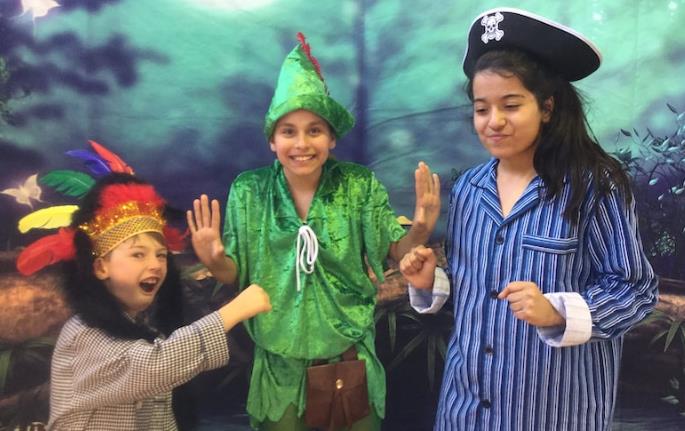
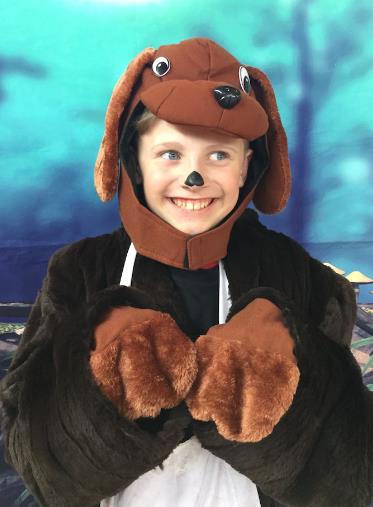
ArtReach's "Peter
Pan" - Ardtornish School, St Agnes, SA Australia
Draw
a picture of yourself with characters in the play. Where would you
be? What would you be doing?
Famous
Peter Pan Quotes
Discuss
what meaning these sayings have for us in our everyday lives. Can
you give an example that illustrates the meaning or image?
"Every
time you say you don't believe in fairies, a fairy dies." - Peter
"Nobody
wants to grow up, Wendy. But we all have to someday." - Mother
"You
just think wonderful thoughts and they lift you in the air." - Peter
"If
you believe clap your hands!"
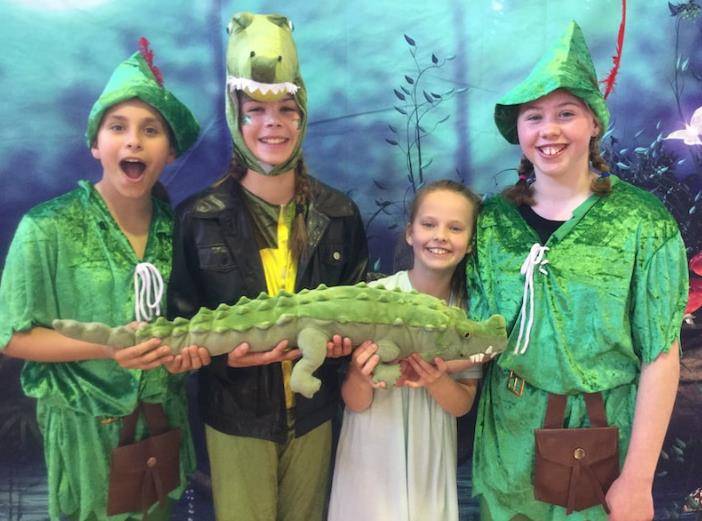
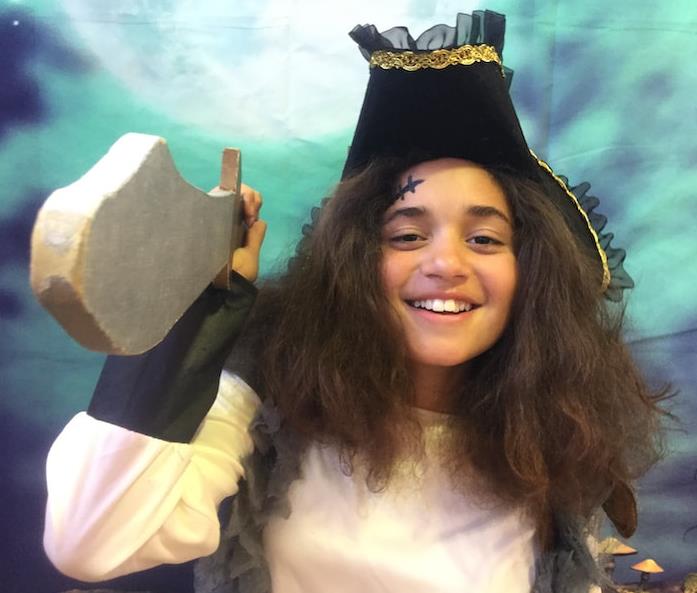
ArtReach's "Peter
Pan" - Ardtornish School, St Agnes, SA Australia
"Tink
says that she thinks she can get well again if children believed in
fairies. Do you believe? If you believe clap your hands, don't let
Tink die!" - Peter
"When
the first baby laughed for the first time, the laugh broke into a
thousand pieces and they all went skipping about, and that was the
beginning of fairies."
-
J. M. Barrie (from Peter Pan)

ArtReach's
Robin Hood - Hollie
Neumann: Costume, Hair, and Makeup Designer
What
does a Costume Designer do?
Costume
designers tell a story through clothing, using the language of
fashion to help express aspects of a play or opera's setting, mood,
and characters. The job is about much more than putting together a
nice outfit, requiring a deep understanding of stage production, a
thorough knowledge of fashion and costuming history, and an eye for
creating standout visual designs. With each wardrobe element and
accessory, costume designers bring the characters and settings to
life, and immerse audiences-and actors-in their time period, culture,
and world.
"Costume
designers tell a story through clothing."
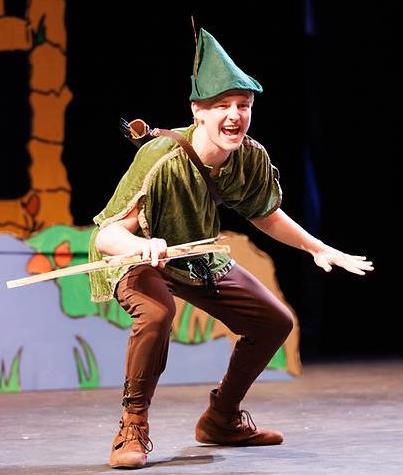

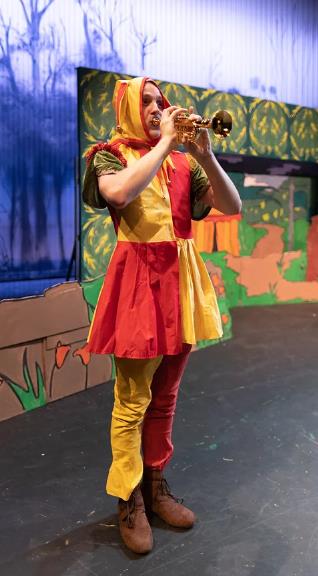
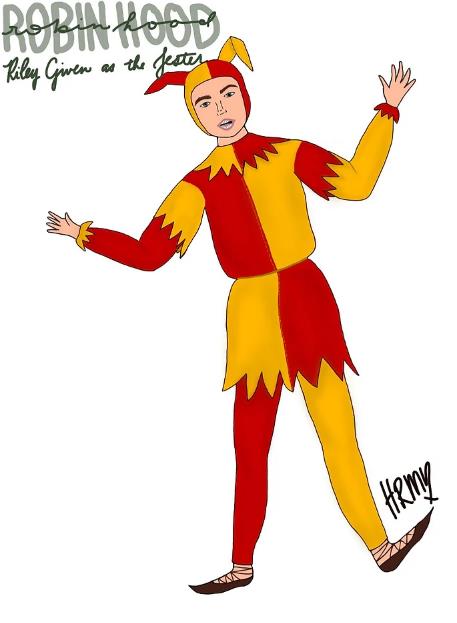
ArtReach's Robin
Hood - Hollie Neumann, Designer for Mt. Hood Community College,
Greshem OR
A
costume designer's job on a production generally begins with a close
reading of the script-getting to know the roles and relationships of
the principal characters-followed by initial meetings with the show's
director, set designer, lighting designer, sound designer, and other
key figures as they nail down a vision for the show's design and
direction. Then, the costume designer begins researching designs,
materials, and colors popular in the period, as well as details like
how they might signify a character's social class. Designers may have
the assistance of a dramaturg in this process, or assign research
topics to members of their costuming team.
"A
designer's job begins with a close reading of the script."
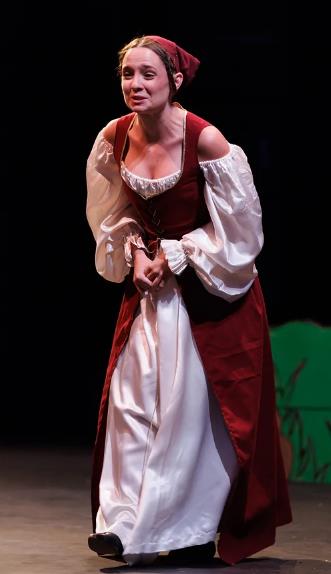

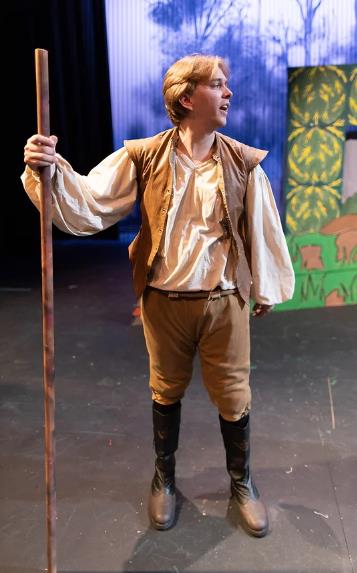
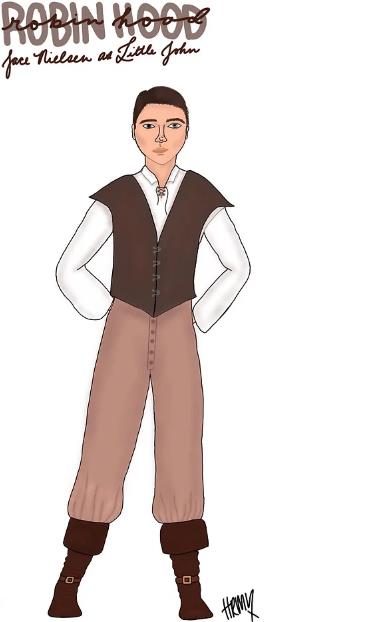
ArtReach's Robin
Hood - Hollie Neumann, Designer for Mt. Hood Community College,
Greshem OR
After
completing research, costume designers use a combination of
sketches, photos, and digitally altered images to create a costume
plot-a visual depiction of each character's costume changes
throughout the production-and present it to the director and other
members of the design team for feedback. Whether purchasing,
creating, or tailoring costume pieces, the costume designer is in
charge of the costume team, budget, and time frame for the project.
They also schedule fittings with actors and oversee costume
alterations and repairs, as well as providing actors and stagehands
with guidelines for their proper care.
"Successful
costume designers work with theater companies."
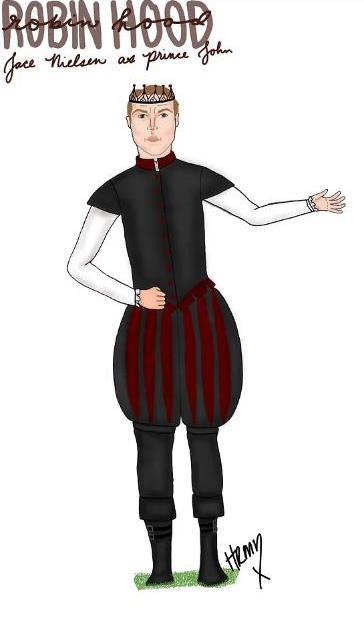
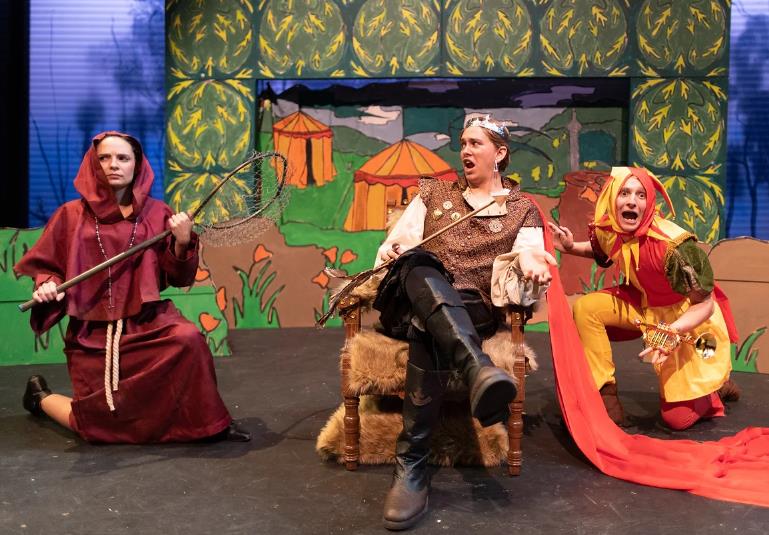
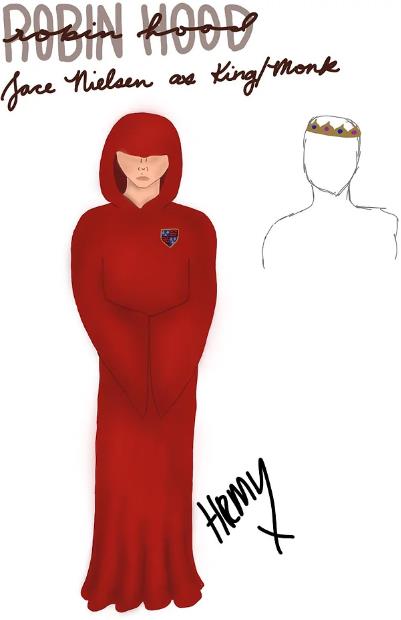
ArtReach's Robin
Hood - Hollie Neumann, Designer for Mt. Hood Community College,
Greshem OR
Career
Path:
Costume designers, who tend to have at least a bachelor's degree and
at most a master's in costuming, usually get their start as costume
makers. They might begin by working on college or community
productions or interning for university costume departments. From
there, they progress to become assistant designers. Successful
costume designers might work with prestigious theater companies on
big-budget productions, transition into designing costumes for films
and TV shows, or lead the design of entire concerts and tours as live
show designers.
Finding
Work: Most
costume designers are freelancers who work on film, television,
theater, and dance productions, although some do find full-time
positions with large theater or opera companies. Costume designers
might also work on music videos, concerts, tours, advertisements, and
fashion shows. Due to the freelance nature of the job, networking and
self-promotion are essential.
"Networking
& self-promotion are vital skills for finding work."
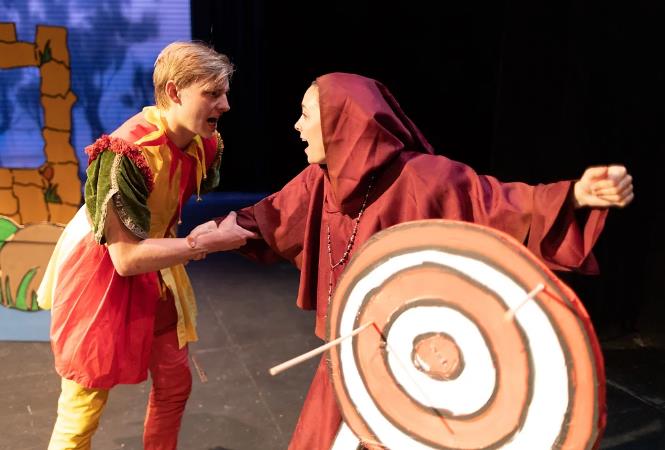
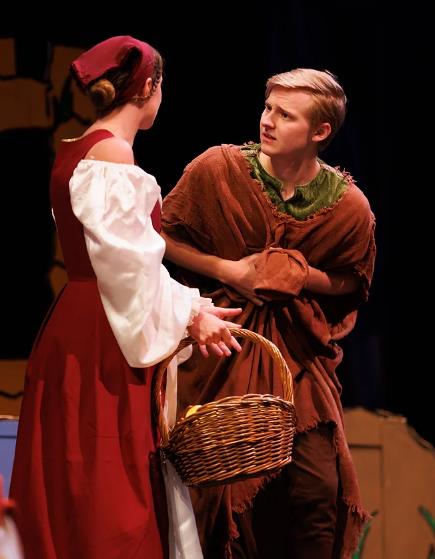
ArtReach's Robin
Hood - Hollie Neumann, Designer for Mt. Hood Community College
Professional
Skills:
Visual design; Machine and hand sewing; Tailoring garments;
Specialized design; cobbling, haberdashery, etc. Broad
knowledge of fashion and costuming history; Deep knowledge of fabrics
and other materials; Making design sketches and costume plots;
Budgeting; Leadership; Text analysis; Time management.
Interpersonal
Skills: Costume
designers are creative, resourceful, observant, and analytical. They
have a deep knowledge of and curiosity about fashion and costuming
history, and are experts in using clothing and accessories to enhance
character and story. Additionally, they must have the attention to
detail, leadership, and time management skills to get projects done
on time. As for most in the theater business, networking and
self-promotion are vital skills for finding work.
"Costume
designers are creative, resourceful, observant."

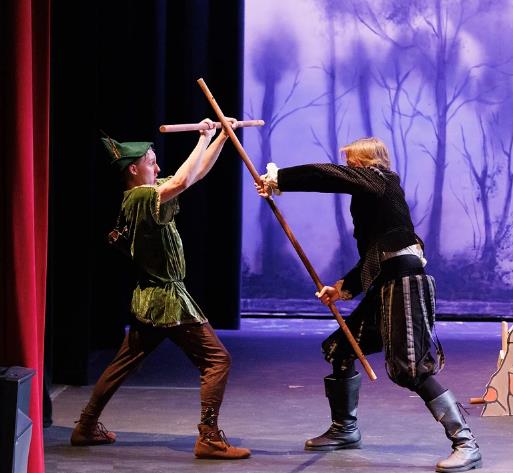
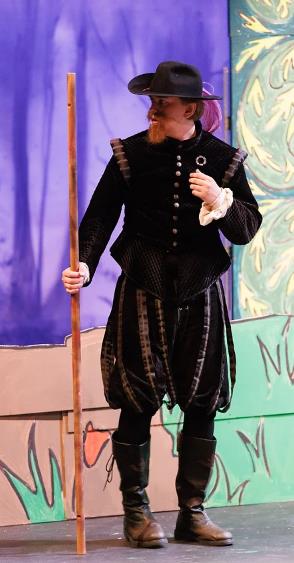
ArtReach's Robin
Hood - Hollie Neumann, Designer for Mt. Hood Community College,
Greshem OR
Work
Life: Costume
designers typically begin researching and creating designs for a
production months before it's staged, although production cycles can
vary greatly. As with many jobs in performing arts, work days tend to
grow longer and less predictable the closer it gets to showtime. At
times, costume designers may work only a couple of hours per day; at
other times, they could work ten-hour days or even all-nighters in
the costume shop.
Article:
Berklee College of Music.
'Tis
the Spooky Season with ArtReach's
'Poe! Poe! Poe!'
by Abigail Grossman
People get together to enjoy a
range of autumn festivities every year. One of the most enduring
activities is the sharing of spooky stories. Who has not gathered
around a fire with family and friends to share terrifying tales of
ghosts and ghouls?
With Halloween close at hand,
if you’re looking for a perfect scary story to tell, look no
further than Edgar Allan Poe, one of the all-time best writers of
horror. “The Black Cat,” one of his most famous works, was
published in 1843. From his jail cell, the narrator recounts his
descent into madness. As the story progresses, they reveal how they
were caught for the devious crimes that landed them in prison.
Although it may seem like a simple tale of a criminal’s lament,
the story is much more complex.
"For
a perfect scary story to tell, look to Edgar Allan Poe."

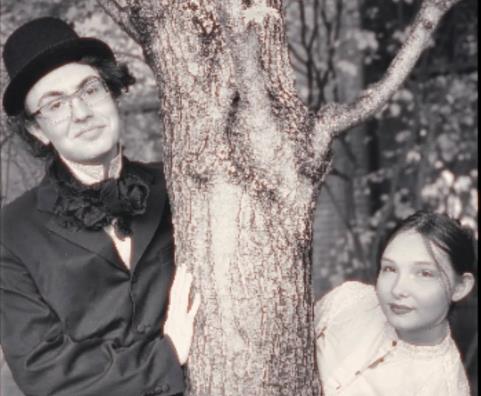
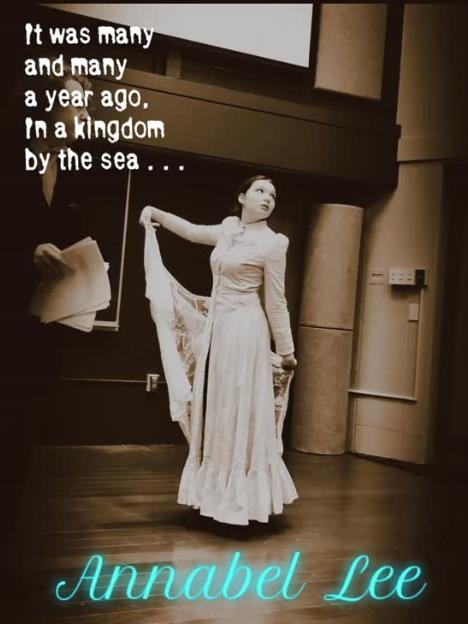
ArtReach's Poe!
Poe! Poe! - FreshBaked Theatre Company, Widener University,
Chester, PA
Poe includes elements of
murder, mystery, and even magic, leaving readers on the edge of their
seats with every line. For these reasons and more, “The Black
Cat” makes for the perfect spooky story to share with loved ones
this Halloween.
That said, there are many
other horror tales by Poe that are worth sharing as well, including
“The Cask of Amontillado” and “The Tell-Tale
Heart.” Read these tales at your own risk, though, because they
will be sure to haunt you!
On a related note, our
university’s very own FreshBaked Theatre Company is performing
Poe! Poe! Poe!, a play by Kathryn Schultz Miller. Public shows are on
November 9th and 15th in the Alumni Auditorium on Widener’s main
campus. The production is free to attend, but any donations will
support charity groups in Chester, Pennsylvania. Quoth the raven:
“We hope to see you there!”
Classroom
Fun: Music, Creative Writing and More
Learning
with the Sleeping Beauty
Teacher's Guide
DIFFERENT
VERSIONS: Read both versions of the story and discuss which elements
are similar and which are different. The castle, fairies, prince,
spinning wheel and the kiss are in both stories. These stories were
written many years ago. Why do you think these are the parts of
the stories that we remember the most?
FOLK
TALES: The Brothers Grimm did not think that they were creating
fairy tales. They were more interested in collecting stories that
ordinary people told each other. Perrault used folk tales and added
to them to create his own story. Discuss how the reasons for both
directions. Consider the stories of another famous fairy tale writer,
Hans Christian Andersen. Is he more like the Grimms or Perrault?
FAIRIES:
Read the section on the history of fairies in this Teacher’s
guide. How do fairies differ from living humans? Are they real or
imaginary? Why do you think these beings play such a strong role in
so many fairy tales? Do you like to pretend that you have a fairy as
a friend. Describe your personal fairy and tell the class what
magical powers your fairy has and why. Write a short story about how
your fairy helped you in a trouble that you have at home, on the
playground or at school.
FAIRY
TALES: Now that you have considered fairies, what do you think makes
up a fairy tale? What must the fairy do in order to make the story
end happily? If you were a fairy what things would you do to make
things end happily in real life?
CREATIVE
WRITING: Have the class write a fairy tale together. Remember to
include the Princess, the Prince, the good fairies and the bad
fairies. To help them create the story, provide them with settings
such as the forest, a mountain, a castle, an island in the sea. Set
it in the past or consider setting their story in the future which
might include cities and outer space. Roll out paper on the floor and
have them draw and paint different scenes from their own story.
SPINNING
WHEELS: Read the section in this Teachers guide about spinning
wheels. What do spinning wheels do and how do they work? How might a
person prick their finger on such a device? Why did they use spinning
wheels in the past but not today?
LIFE
IN THE MIDDLE AGES: Talk about how the spinning wheel was one of the
chores of a medieval family. Read the section in this Teacher’s
Guide about Life in a Medieval Village. What other chores might they
do that we do not do today? Would you like to live in those times or
do you think it is better to live today? What might be better? What
might be worse.
MUSIC:
Listen to a recording of The Sleeping Beauty ballet by Pyotr
Tchaikovsky. Much of the music in the play is taken from this ballet.
Listen to various movements and discuss how the tempo and composition
enhances the story. Can you pick out which parts are identified with
Morgana and which parts are identified with the fairies?
The
Nutcracker Prince
Classroom
Activities & Discussions from ArtReach's Teacher's Guide for The
Nutcracker Prince.
LAND
OF SWEETS:
Imagine you could enter Clara's gingerbread castle and pass through
to a fantasy land. Clara visits a land that is filled with
candy. What kind of place would you like to visit? What
would you like to see there? Animals, cartoons, toys, stars and
planets? Draw a picture of your own special Land.
SUGAR
PLUM FAIRY: Many
years ago, when Tchaikovsky wrote the Nutcracker, children were used
to receiving sugarplums for Christmas. What kind of treats do
you look forward to? Ask a grownup for a recipe book and ask
them to help you make treats for your class.
"Draw
a picture of your own special Land."

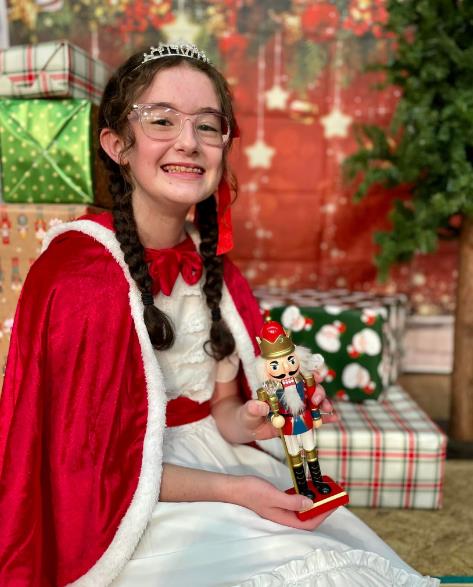
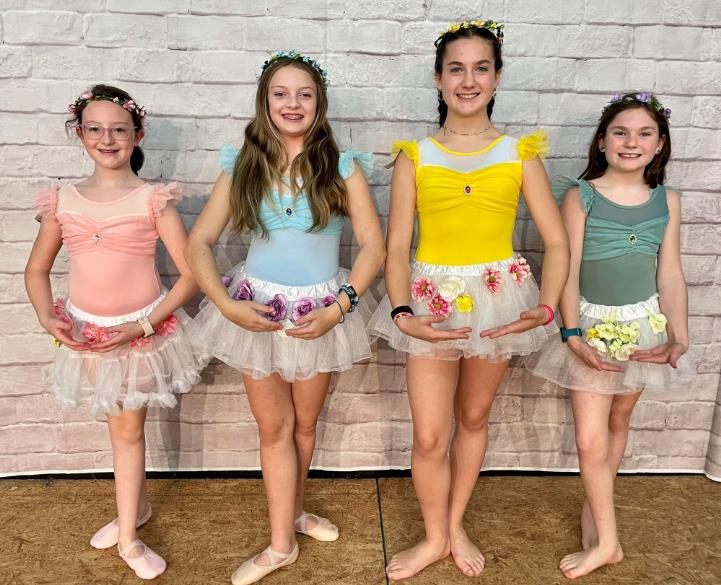
ArtReach's The
Nutcracker Prince -
JFK Catholic School, Washington PA
BATTLE:
Divide the class up
between mice and toy soldiers. Huddle with your group like
football players do and think up a strategy to win. Play the
Tchaikovsky music for the battle scene in the Nutcracker and have
your own battle!
DREAMS:
What's the craziest dream you ever had? What's the
scariest? Draw a picture of your dream and show it to the
class. Have students give each other suggestions on what they
would do if they found themselves in that dream situation.
"Imagine
you could enter Clara's gingerbread castle."
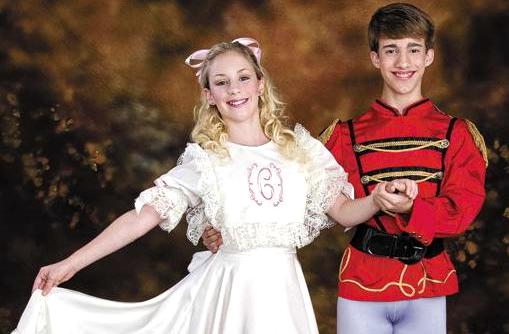

ArtReach's The
Nutcracker Prince
CHRISTMAS
GIFTS: Fritz
thought Clara's gift, a nutcracker was ugly and strange. What
strange gift have you received? Talk about how you feel when
you get an unusual gift. Do you hate it or try to love it as
Clara did? What are the advantages of accepting a gift you
might not have expected? Consider the gifts you will give this
Christmas and tell your friends why you have chosen to give those items.
MUSIC:
Choose an
instrument from the orchestra in the list shown in this guide.
Imagine that the instrument is actually a character or an
animal. How does it sound, walk, sing? Put a silly
orchestra together with your friends. Try singing Christmas
carols together - stay in character as you sing for a kooky song!
"Ask
kids to make up their own dances."
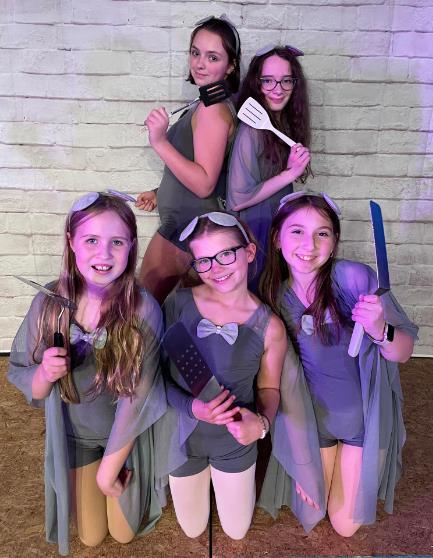


ArtReach's The
Nutcracker Prince -
JFK Catholic School, Washington PA
DANCE:
The Nutcracker music was written for ballet. Play some of the
different parts of the music and ask kids to make up their own
dances. It can be any kind of dance they enjoy. Have the
kids discuss their favorite dances and then do them together.
"Only
those who truly love and who are truly strong can sustain their
lives as a dream. You dwell in your own enchantment. Life throws
stones at you, but your love and your dream change those stones into
the flowers of discovery."
Ben
Okri
The
Legend of Origami Cranes
PCPA (Pacific
Conservatory Theatre, CA) Study Guide for ArtReach's Play, A
Thousand Cranes
A
Thousand origami cranes is a group of one thousand origami paper
cranes held together by strings. An ancient Japanese legend promises
that anyone who folds a thousand origami cranes will be granted a
wish by a crane. Some stories believe you are granted eternal good
luck, instead of just one wish, such as long life or recovery from
illness or injury. This makes them popular gifts for special friends
and family. The crane in Japan is one of the mystical or holy
creatures (others include the dragon and the tortoise) and is said to
live for a thousand years: That is why 1000 cranes are made, one for
each year. In some stories it is believed that the 1000 cranes must
be completed within one year and they must all be made by the person
who is to make the wish at the end.
A
thousand paper cranes are traditionally given as a wedding gift by
the father, who is wishing a thousand years of happiness and
prosperity upon the couple. They can also be given to a new baby for
long life and good luck. Hanging them in one's home is thought to be
a powerfully lucky and benevolent charm.
"Anyone
who folds a thousand origami cranes will be granted a wish."
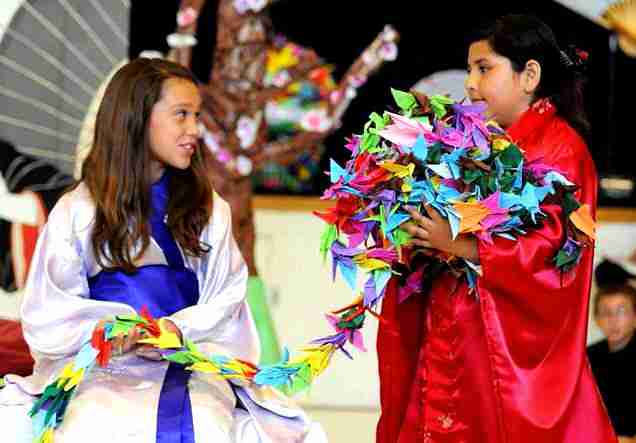
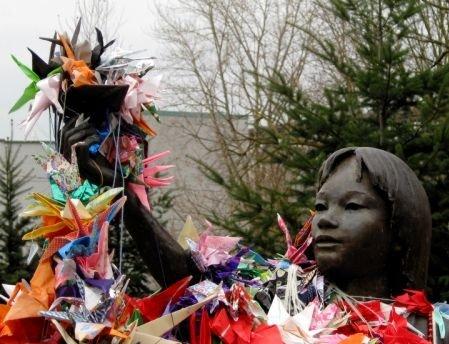
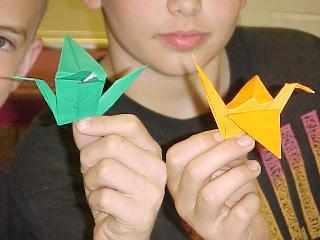
Several
temples, including some in Tokyo and Hiroshima, have eternal flames
for world peace. At these temples, school groups or individuals often
donate origami cranes to add to the prayer for peace. The cranes are
left exposed to the elements, slowly dissolving and becoming tattered
as the wish is released.
Sets
of origami paper are sold widely in Japan, with senbazuru sets
including 1000 (or more, in case of mistakes) sheets of paper,
string, and beads to place at the end of each string to stop the
cranes from slipping off. Commonly the cranes are assembled as 25
strings of 40 cranes each.
"Temples
have eternal flames for world peace."
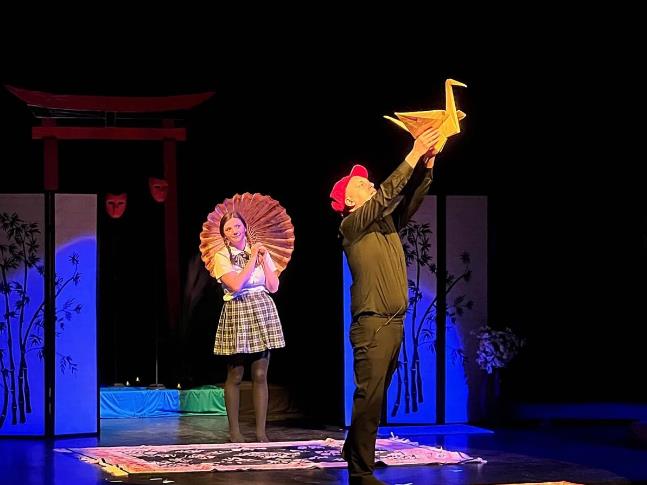
Silver Stage
Players, Great Basin Theatre, Elko NV
The
size of the origami paper does not matter when assembling a thousand
paper cranes, but smaller sheets consequently yield smaller and
lighter strings of cranes. The most popular size for senbazuru is 75
by 75 millimetres (3.0 in × 3.0 in). Some people cut their own
squares of paper from anything available, such as magazines,
newspapers, notebooks, and printer paper.
When
learning as a production team at PCPA, we used plain copy paper and
folded it into a square and cut off the small excess strip. This was
an inexpensive way to learn and practice. When we were more confident
in our skills, we used colored copy paper and eventually origami
paper. Origami paper is usually of a solid color, though printed
designs are available. Larger size origami paper, usually 6x6 inches,
often has traditional Japanese or flower designs, reminiscent of
kimono patterns.
See
entire Study Guide here: https://www.pcpa.org/outreach/1000cranesstudyguide.pdf
ArtReach's
The Legend
of Mulan Offers Martial Arts Opportunities
Learn Something New!
WHAT IS MARTIAL ARTS?
This article is for all the
fans of Jackie Chan, Bruce Lee, Jet Lee and Ninja turtles. How and
where did the martial arts originate? This is perhaps one of the most
debatable questions in the history that continues to puzzle the
historians till date. If you ask ten different people, even from the
same country, you will get ten different answers.
Martial art is the "art
of combat" or "art of waging war". It comprises of a
set of intricate movements that can be used for offensive or
defensive purposes. Most historians believe that martial arts first
originated in India. During 11th and 12th century AD, there was a
popular form of martial arts, known as Kalaripayattu prevalent in the
southern states of India. Bodhidharma, a famous Buddhist monk, learnt
this art in India and when he went to China to propagate Buddhism, he
introduced this art of fighting to the Chinese. He later incorporated
certain changes in the Kalaripayattu way of fighting and gave birth
to a new form of martial arts known as the Shaolin Kung Fu.
"Nearly
every culture on earth develops its own form of self-defense."
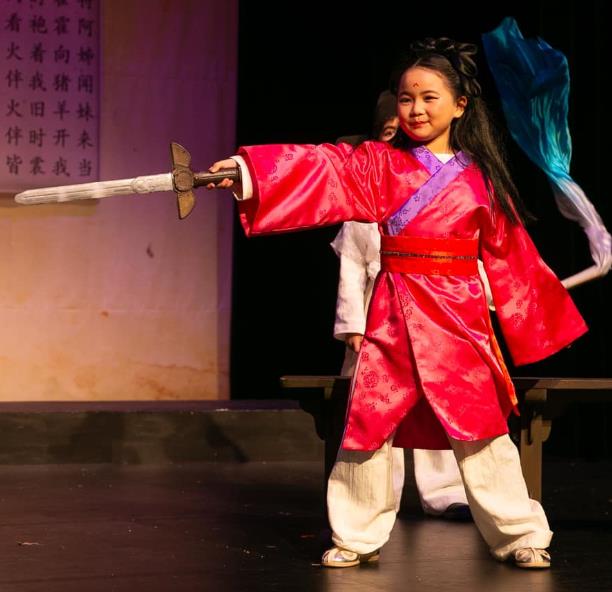
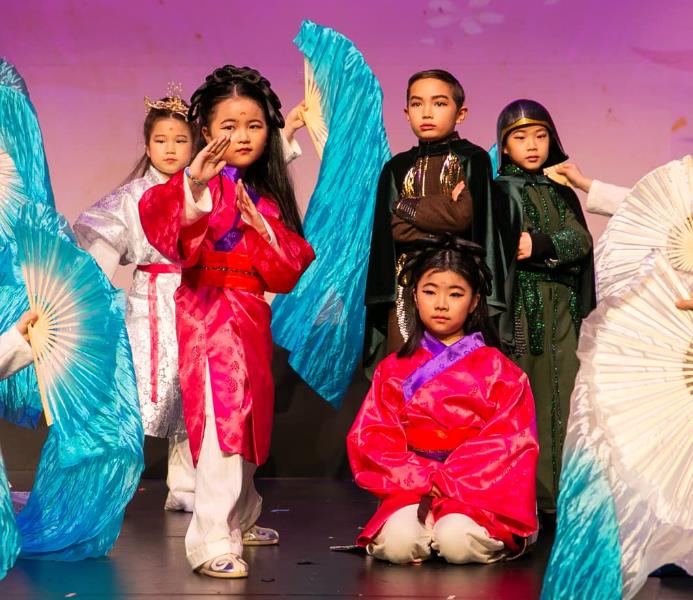
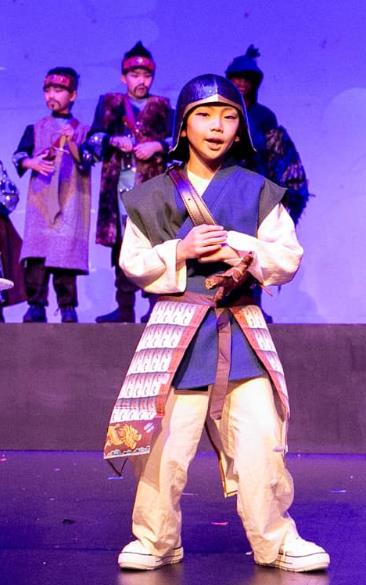
ArtReach's The
Legend of Mulan - Seoul Foreign School, Seoul, South Korea
The need of protecting oneself
made nearly every culture on earth develop its own form of
self-defense and myriad forms of martial arts are in practice since
time immemorial.
Types of
Martial Types of Martial Arts
The early Greek culture
practiced a martial art known as Pankration, the art of complete
strength. Pankration comprised of an eclectic mix of combative styles
of wrestling, grappling and boxing techniques.
Sambo is a Russian martial art
and combat sport. This combat style is based on ancient wrestling
techniques and is now taught to the Russian military for hand to hand
combat training.
Martial
arts are part of The
Legend of Mulan


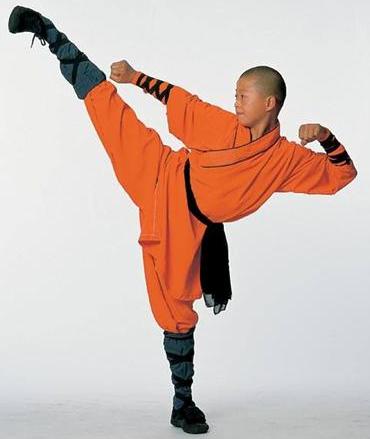
Great opportunities for
students who study martial arts & acrobatics.
The ancient Romans also
practiced martial arts and incorporated the use of various weapons
and armors. They enjoyed the contests between man and beast in a
fight to the death.
One of the most popular forms
of martial arts, Karate, is said to have originated on the island of
Okinawa in Japan, thousands of years ago. Since weapons were banned
in Okinawa, the Okinawans developed strong hand-fighting techniques
in order to defend themselves.
Another popular martial arts
form Tae Kwon Do originated around 1300 years ago in Korea and is one
of the oldest surviving martial arts. The origin of this combat form
can be traced back to Buddhist monks who studied first in China and
then brought their teachings to Korea.
Initially, China did not want
to share the secrets of her martial arts strategies with other
countries, but in the late 1960s, China began to slowly open their
doors to the West, sharing her unique culture and traditions with the
rest of the world. Bruce Lee, Jackie Chan, Jet Li and others brought
introduced Kung Fu to mainstream America through Hollywood, unveiling
the enigmatic techniques of martial arts before the common man.
"Martial
arts teach us self-defense and increase our confidence."
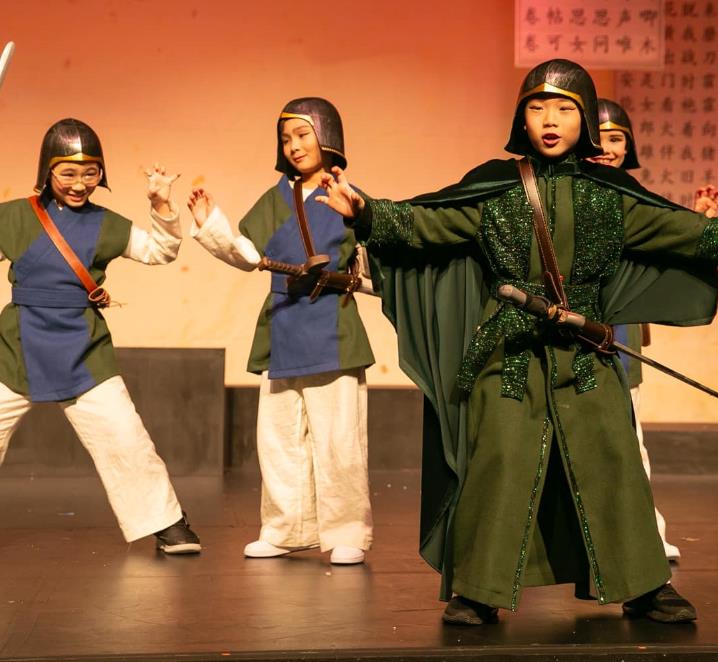

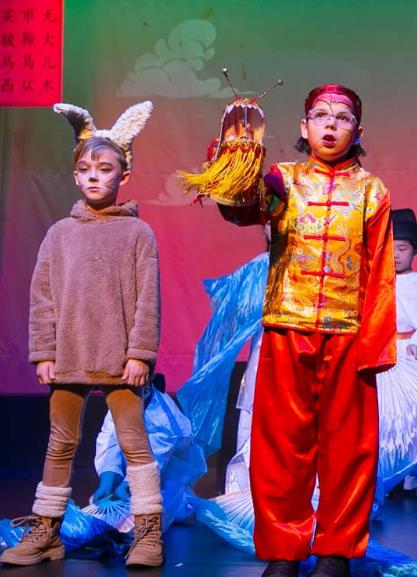
ArtReach's The
Legend of Mulan - Seoul Foreign School, Seoul, South Korea
Banned in Okinawa, the
Okinawans developed strong hand-fighting techniques in order to
defend themselves. Another popular martial arts form Tae Kwon
Do originated around 1300 years ago in Korea and is one of the oldest
surviving martial arts. The origin of this combat form can be traced
back to Buddhist monks who studied first in China and then brought
their teachings to Korea.
Initially, China did not want
to share the secrets of her martial arts strategies with other
countries, but in the late 1960s, China began to slowly open their
doors to the West, sharing her unique culture and traditions with the
rest of the world. Bruce Lee, Jackie Chan, Jet Li and others brought
introduced Kung Fu to mainstream America through Hollywood, unveiling
the enigmatic techniques of martial arts before the common man.
The truth of the matter is
most martial arts are similar. They all teach similar principles,
just in different ways. It's like religion. There are so many
different religions around the world, having different ways of
worship and different deities, but all teach us only one thing,
"God is one." Similarly, the one thing all martial arts
have in common is that they teach us self-defense and increase our
confidence level.
"You
will never do anything in this world without courage.
It
is the greatest quality of the mind next to honor."
-- Aristotle
Puppets
Help Enact the Lesson of the Day
How puppets are
effective teaching aids for kids
By Christie Belfiore
A puppet is defined as a
movable inanimate object or figure that is controlled by strings,
rods, or by placing one's hand inside its body. There are various
types from finger puppets to hand puppets, pop-up puppets to paddle
puppets, and marionettes to shadow puppets. A very ancient art form
believed to have originated 3,000 years ago, puppetry has been
practiced among many cultures throughout the history of civilization.
The expressiveness and dramatization of puppets have not only
entertained people for thousands of years, but have also been used to educate.
"Puppets
are Great for Innovative Teaching!"
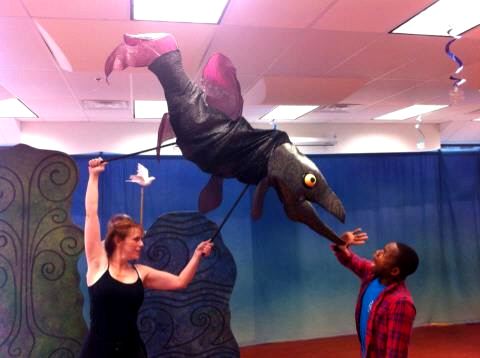
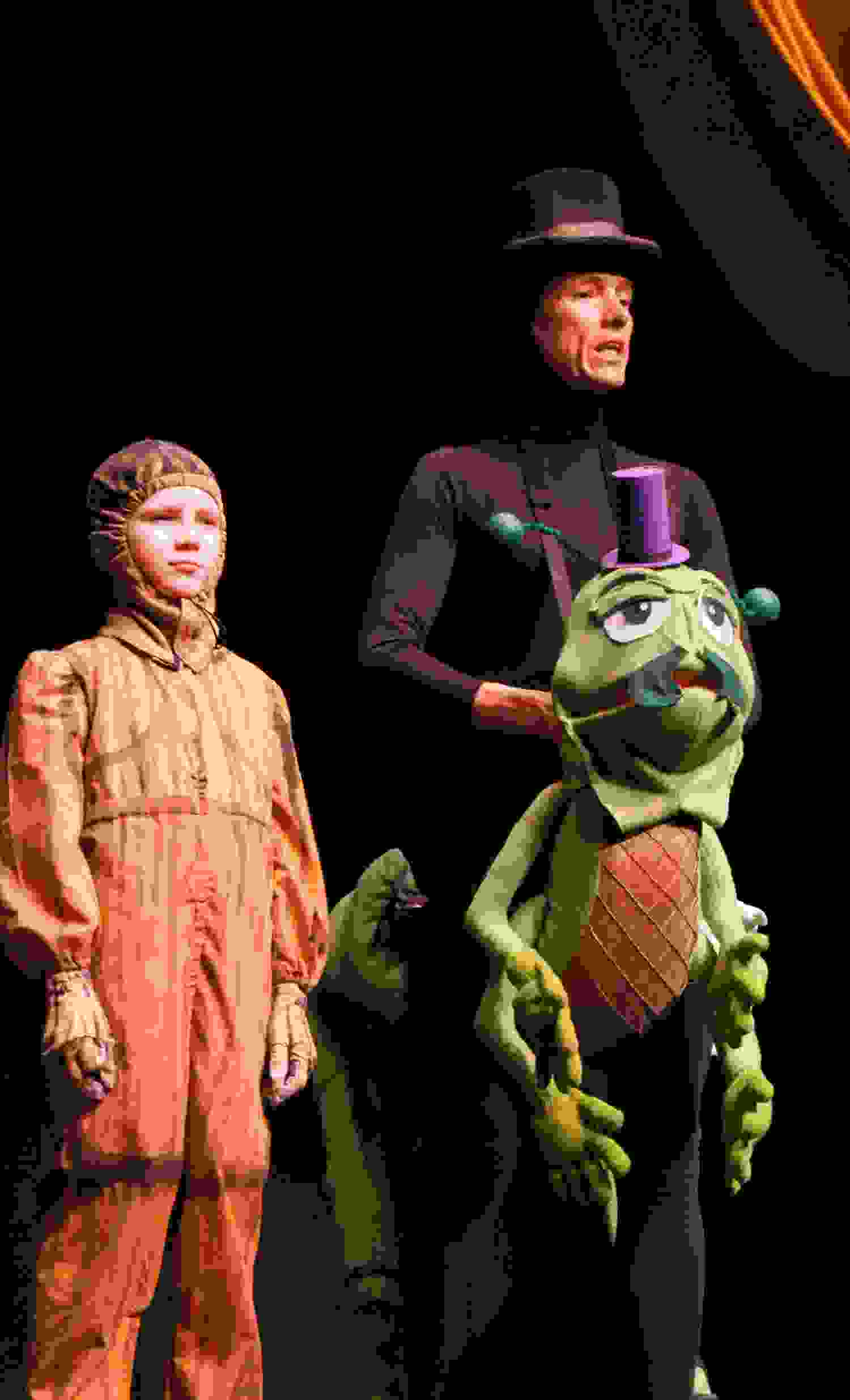
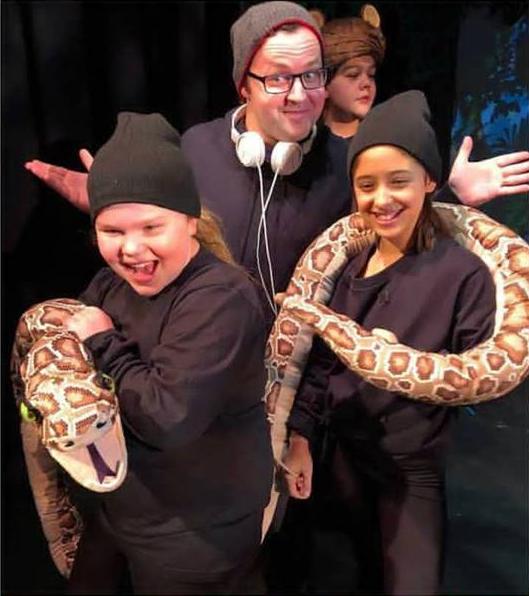
Puppets in ArtReach Plays: Sword
in the Stone, Pinocchio,
The Jungle Book
Over the centuries, puppets
have remained a powerful form of communication between people. From
Asia to Europe, Africa to the Americas, puppetry is a familiar art
form that has been predominantly used for telling stories, preaching
religious beliefs, and discussing cultural practices, but mainly,
sharing knowledge. Puppetry in the classroom can be used in the same
way. Beginning as a progression from child-friendly cartoons, such as
the Muppets, to an educational tool for sounding out and pronouncing
words, their multi-purpose functionality allows children's minds to
create, explore, and flourish. Puppets aid students to speak aloud in
a group setting, allowing them to talk about serious and
uncomfortable issues. Not only that, puppets are also a wonderful
visual aid for children, retaining their attention and encouraging
them to participate in class. Children are more willing to learn when
they are having fun, and puppets are a gateway to opening up the mind
and inviting knowledge in. Kids' imaginations can run wild, and
without knowing it, they are developing essential skills needed for
everyday life, just as they did thousands of years ago.